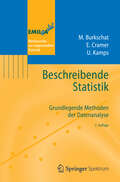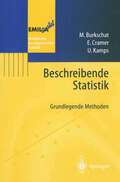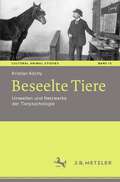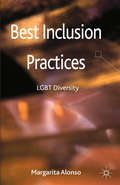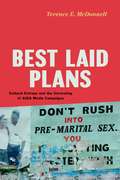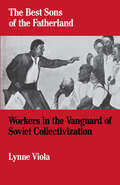- Table View
- List View
Beschäftigungschancen und Betriebszugehörigkeit: Die Folgen betrieblichen Wandels für ostdeutsche Erwerbstätige nach 1989
by Anne GoedickeIndividuelle Erwerbsverläufe werden wesentlich durch die betriebliche Organisation von Arbeit, durch das Arbeitsplatzangebot und die personalstrategische Ausrichtung von Betrieben bestimmt. Die ostdeutsche Betriebslandschaft war nach 1989 in besonderem Maße durch Gründungen, Schließungen und die Reorganisation von Unternehmen gekennzeichnet. Auf der Grundlage von Theorien betriebsorientierter Mobilitätsforschung untersucht diese Studie an Hand von Daten der Lebensverlaufsstudie des Max-Planck-Instituts für Bildungsforschung Erwerbsrisiken und zwischenbetriebliche Wechsel ostdeutscher Frauen und Männer nach 1989. Erkundet werden dabei die Bedeutung der Betriebszugehörigkeit zu Beginn der Transformation, Ausschlussprozesse am Arbeitsmarkt sowie die Herausbildung des neuen Beschäftigungssystems in den ostdeutschen Bundesländern. Besondere Aufmerksamkeit gilt konzeptionell wie empirisch der Situation raschen wirtschaftsstrukturellen Wandels.
Beschreibende Statistik: Grundlegende Methoden der Datenanalyse (EMIL@A-stat)
by Marco Burkschat Erhard Cramer Udo KampsIn dem Band werden die Grundlagen und die Methoden der Beschreibenden Statistik erläutert. Wie Tabellen, Graphiken und charakteristische Maßzahlen jeweils eingesetzt werden können, um die wesentlichen Informationen deutlich hervorzuheben, vermitteln die Autoren problem- und zielorientiert: Zu Beginn jedes Kapitels werden anhand eines Beispiels Fragen der methodengestützte Analyse diskutiert, dann wird der vorgestellte Datensatz ausführlich bearbeitet, so dass die Methoden und deren Nutzen für Leser anschaulich werden.
Beschreibende Statistik: Grundlegende Methoden (EMIL@A-stat)
by Marco Burkschat Erhard Cramer Udo KampsAufgabe der beschreibenden Statistik ist es, gewonnene Daten so darzustellen, dass das Wesentliche deutlich hervortritt. Sie bedient sich dazu hauptsächlich dreier Formen: Tabellen, graphische Darstellungen und charakteristische Maßzahlen. Das vorliegende Buch führt umfassend in die Grundlagen und Methodik der beschreibenden Statistik ein. Besonderer Wert wird dabei auf die problem- und zielorientierte Aufbereitung des Stoffes gelegt. Zu Beginn eines jeden Kapitels werden an einem praxisorientierten Beispiel, dessen Datenmaterial nicht unmittelbar bewertbar ist, Fragen aufgeworfen, die auf die methodengestützte Analyse des Datensatzes abzielen. Die Fragen geben gleichzeitig einen Überblick über die im entsprechenden Kapitel behandelte Thematik und führen dazu, dass der Leser zunächst umgangssprachlich genannte Begriffe lernt zu konkretisieren und zu formalisieren, da nur so eine Analyse der Daten möglich ist. Der zu Beginn eines Kapitels vorgestellte Datensatz wird dann durchgehend in der Vermittlung des Stoffes betrachtet und so die eingeführten Methoden und deren Nutzen anschaulich demonstriert. Das Buch wird ergänzt durch das Schwesterprodukt: Cramer et al.: Beschreibende Statistik - Interaktive Graphiken
Beschreibende Statistik: Interaktive Grafiken (EMIL@A-stat)
by Erhard Cramer K. Cramer Udo Kamps C. ZuckschwerdtErgänzend zu der formalen Darstellung eines herkömmlichen Lehrbuches, bieten die Autoren einen visuellen Zugang zur beschreibenden Statistik. In Form interaktiver JAVA-Applets, die mit einem gebräuchlichen Internetbrowser verwendet werden können, werden grundlegende graphische Methoden vorgestellt. Die Applets ermöglichen aufgrund ihre einfache Bedienung nicht nur einen schnellen visuell orientierten Lernerfolg sondern lassen sich darüber hinaus auch zur Erstellung einfacher Präsentationsgraphiken verwenden. Zu jedem Applet ist eine detaillierte Beschreibung erstellt worden, die den Stellenwert und Bedeutung des vorgestellten Verfahren ausführlich erläutert sowie seine Funktionalität und Bedienung aufzeigt. Aufgrund der Vielzahl der angebotenen Graphiken fokussiert sich das Buch auf die Vorstellung der wesentlichen Konzepte und Methoden der beschreibenden Statistik und stellt diese interaktiv, also aus einem anderen Blickwinkel, dar. Die vorgestellten Applets sowie verschiedene Datensätze können via Internet heruntergeladen werden. Zudem besteht die Möglichkeit eigene Daten einzulesen und darzustellen. Folgende Features runden die Applets ab: bildschirmfüllende Darstellung, freie Beschriftung der Graphiken, Druckfunktion. Zu den "Interaktiven Graphiken" ist das Schwesterbuch erhältlich: Brukschat et al: Beschreibende Statistik - Grundlegende Methoden.
Beseelte Tiere: Umwelten und Netzwerke der Tierpsychologie (Cultural Animal Studies #13)
by Kristian KöchyDie Tierpsychologie ist zu Beginn des 20. Jahrhunderts eine prominente Forschungsrichtung zwischen Biologie, Psychologie und Philosophie. Sie fragt nach psychischen Vermögen von Tieren. In essayhaften Studien zu namhaften Protagonisten werden im Buch Forschungskontexte der Tierpsychologie vorgestellt. Die ausgewählten Positionen verstehen menschliche Wahrnehmung ebenso gestalthaft wie die Forschungsgegenstände, die Tiere in ihren Umwelten. Das Buch untersucht Beziehungen von Philosophie und Wissenschaft, skizziert aber zudem eine Philosophie der Tierforschung, die die Interaktion von menschlichen und tierlichen Subjekten anerkennt.
Besinnung in flexiblen Zeiten: Leibliche Perspektiven auf postmoderne Arbeit
by Jörg SchröderMerkmale und Beweggründe eines "flexiblen Menschen" herauszufinden hatte von Beginn meines Entschlusses, darüber zu promovieren, (anfangs unbewusst, später bewusster) auch mit mir selbst zu tun, mit meinem eigenen nomadischen Lebensweg über viele Städte und Dörfer der Bundesrepublik. Eingeflossen sind Wertvorstellungen und Erfahrungen meiner Eltern, Margot und Wolfgang Schröder, aus ihrer eigenen Geschichte als aktive Mitstreiter in der Arbeiter- wegung in beiden deutschen Staaten, ebenso wie Denkanstöße von Wolf und Frigga Haug, sich die herrschende Wirklichkeit über die "Philosophie der Praxis" von Marx zu erschließen. In Projekten zur Humanisierung des Arbeitslebens bei der IG Metall und als gewerkschaftlicher Technologieberater lernte ich, wie die Arbeitenden zwar die Herausforderungen moderner Technik souverän bewält- ten, gleichzeitig aber mit sich selbst mehr oder weniger unachtsam umgingen. Einer wichtigen Voraussetzung für einen anderen Umgang mit sich selbst konnte ich dann im Studium der Motologie in der Begegnung mit der Leibphänome- logie "am eigenen Leibe" auf die Spur kommen: über die subjektive Wahrn- mung und über das Erleben meiner selbst, über die Wertschätzung des eigenen Empfindens und der eigenen Lebensgeschichte. Jürgen Seewald als Leiter des Aufbaustudiengangs Motologie in Erfurt, als Kollege im dortigen Lehrteam Motologie und als "Doktorvater" der Dissertation sowie Fritz Reheis als Wissenschaftler und guter Freund, der mir mindestens 5 mal sein Haus in Rödental als Klausurstätte in der intensiven Schlussphase der Arbeit zur Verfügung stellte und mich wissenschaftlich "coachte", waren e- scheidende Wegbereiter für den erfolgreichen Abschluss der Arbeit.
Besser und erfolgreicher kommunizieren: Techniken, Selbsteinschätzungen, soziale Situationen und kommunikative Strategien
by Christina Klüver Jürgen Klüver Jörn SchmidtDieses Buch gibt Orientierungen und Hilfestellungen, wie man bewusst an den eigenen kommunikativen Fähigkeiten arbeiten und diese verbessern kann. Wie bereitet man einen Vortrag vor, was ist bei Medien zu beachten, wie geht man mit Nervosität um, wie erfasst man Stimmungen bei den Zuhörern?Wie erkennt man die eigene Rolle in einer sozialen Gruppe, wie verarbeitet man kommunikative Misserfolge und wie lernt man aus eigenen Fehlern? Und vor allem: Wie lernt man soziale, kommunikative Situationen und sich selbst einzuschätzen, um als eigenständige Persönlichkeit wahrgenommen zu werden und zu überzeugen?Um diese Fähigkeiten zu lernen, ist es insbesondere wichtig, kommunikative Situationen und kommunikative Prozesse richtig einschätzen zu können. Auch dazu werden hier verschiedene Hinweise gegeben, die für das Verständnis situationsbedingter und themenspezifischer Kommunikationen und deren spezifische Schwierigkeiten eine hilfreiche Orientierung geben.Zusätzliche Fragen per App: Laden Sie die Springer Nature Flashcards-App kostenlos herunter und nutzen Sie exklusives Zusatzmaterial als Printbuchkäufer, um Ihr Wissen zu prüfen.
Best Inclusion Practices: LGBT Diversity
by M. AlonsoAims to increase awareness about the specific circumstances of LGBT (lesbian, gay, bisexual, and transgender) diversity. Based on a wide array of literature this volume provides a global vision of this reality, explaining the evolution of homosexuality during history and reasons why it has been considered a sin, an illness and a crime.
Best Laid Plans: Cultural Entropy and the Unraveling of AIDS Media Campaigns
by Terence E. McDonnellWe see it all the time: organizations strive to persuade the public to change beliefs or behavior through expensive, expansive media campaigns. Designers painstakingly craft clear, resonant, and culturally sensitive messaging that will motivate people to buy a product, support a cause, vote for a candidate, or take active steps to improve their health. But once these campaigns leave the controlled environments of focus groups, advertising agencies, and stakeholder meetings to circulate, the public interprets and distorts the campaigns in ways their designers never intended or dreamed. In Best Laid Plans, Terence E. McDonnell explains why these attempts at mass persuasion often fail so badly. McDonnell argues that these well-designed campaigns are undergoing “cultural entropy”: the process through which the intended meanings and uses of cultural objects fracture into alternative meanings, new practices, failed interactions, and blatant disregard. Using AIDS media campaigns in Accra, Ghana, as its central case study, the book walks readers through best-practice, evidence-based media campaigns that fall totally flat. Female condoms are turned into bracelets, AIDS posters become home decorations, red ribbons fade into pink under the sun—to name a few failures. These damaging cultural misfires are not random. Rather, McDonnell makes the case that these disruptions are patterned, widespread, and inevitable—indicative of a broader process of cultural entropy.
Best Laid Plans: Cultural Entropy and the Unraveling of AIDS Media Campaigns
by Terence E. McDonnellWe see it all the time: organizations strive to persuade the public to change beliefs or behavior through expensive, expansive media campaigns. Designers painstakingly craft clear, resonant, and culturally sensitive messaging that will motivate people to buy a product, support a cause, vote for a candidate, or take active steps to improve their health. But once these campaigns leave the controlled environments of focus groups, advertising agencies, and stakeholder meetings to circulate, the public interprets and distorts the campaigns in ways their designers never intended or dreamed. In Best Laid Plans, Terence E. McDonnell explains why these attempts at mass persuasion often fail so badly. McDonnell argues that these well-designed campaigns are undergoing “cultural entropy”: the process through which the intended meanings and uses of cultural objects fracture into alternative meanings, new practices, failed interactions, and blatant disregard. Using AIDS media campaigns in Accra, Ghana, as its central case study, the book walks readers through best-practice, evidence-based media campaigns that fall totally flat. Female condoms are turned into bracelets, AIDS posters become home decorations, red ribbons fade into pink under the sun—to name a few failures. These damaging cultural misfires are not random. Rather, McDonnell makes the case that these disruptions are patterned, widespread, and inevitable—indicative of a broader process of cultural entropy.
Best Laid Plans: Cultural Entropy and the Unraveling of AIDS Media Campaigns
by Terence E. McDonnellWe see it all the time: organizations strive to persuade the public to change beliefs or behavior through expensive, expansive media campaigns. Designers painstakingly craft clear, resonant, and culturally sensitive messaging that will motivate people to buy a product, support a cause, vote for a candidate, or take active steps to improve their health. But once these campaigns leave the controlled environments of focus groups, advertising agencies, and stakeholder meetings to circulate, the public interprets and distorts the campaigns in ways their designers never intended or dreamed. In Best Laid Plans, Terence E. McDonnell explains why these attempts at mass persuasion often fail so badly. McDonnell argues that these well-designed campaigns are undergoing “cultural entropy”: the process through which the intended meanings and uses of cultural objects fracture into alternative meanings, new practices, failed interactions, and blatant disregard. Using AIDS media campaigns in Accra, Ghana, as its central case study, the book walks readers through best-practice, evidence-based media campaigns that fall totally flat. Female condoms are turned into bracelets, AIDS posters become home decorations, red ribbons fade into pink under the sun—to name a few failures. These damaging cultural misfires are not random. Rather, McDonnell makes the case that these disruptions are patterned, widespread, and inevitable—indicative of a broader process of cultural entropy.
Best Laid Plans: Cultural Entropy and the Unraveling of AIDS Media Campaigns
by Terence E. McDonnellWe see it all the time: organizations strive to persuade the public to change beliefs or behavior through expensive, expansive media campaigns. Designers painstakingly craft clear, resonant, and culturally sensitive messaging that will motivate people to buy a product, support a cause, vote for a candidate, or take active steps to improve their health. But once these campaigns leave the controlled environments of focus groups, advertising agencies, and stakeholder meetings to circulate, the public interprets and distorts the campaigns in ways their designers never intended or dreamed. In Best Laid Plans, Terence E. McDonnell explains why these attempts at mass persuasion often fail so badly. McDonnell argues that these well-designed campaigns are undergoing “cultural entropy”: the process through which the intended meanings and uses of cultural objects fracture into alternative meanings, new practices, failed interactions, and blatant disregard. Using AIDS media campaigns in Accra, Ghana, as its central case study, the book walks readers through best-practice, evidence-based media campaigns that fall totally flat. Female condoms are turned into bracelets, AIDS posters become home decorations, red ribbons fade into pink under the sun—to name a few failures. These damaging cultural misfires are not random. Rather, McDonnell makes the case that these disruptions are patterned, widespread, and inevitable—indicative of a broader process of cultural entropy.
Best Laid Plans: Cultural Entropy and the Unraveling of AIDS Media Campaigns
by Terence E. McDonnellWe see it all the time: organizations strive to persuade the public to change beliefs or behavior through expensive, expansive media campaigns. Designers painstakingly craft clear, resonant, and culturally sensitive messaging that will motivate people to buy a product, support a cause, vote for a candidate, or take active steps to improve their health. But once these campaigns leave the controlled environments of focus groups, advertising agencies, and stakeholder meetings to circulate, the public interprets and distorts the campaigns in ways their designers never intended or dreamed. In Best Laid Plans, Terence E. McDonnell explains why these attempts at mass persuasion often fail so badly. McDonnell argues that these well-designed campaigns are undergoing “cultural entropy”: the process through which the intended meanings and uses of cultural objects fracture into alternative meanings, new practices, failed interactions, and blatant disregard. Using AIDS media campaigns in Accra, Ghana, as its central case study, the book walks readers through best-practice, evidence-based media campaigns that fall totally flat. Female condoms are turned into bracelets, AIDS posters become home decorations, red ribbons fade into pink under the sun—to name a few failures. These damaging cultural misfires are not random. Rather, McDonnell makes the case that these disruptions are patterned, widespread, and inevitable—indicative of a broader process of cultural entropy.
Best Laid Plans: Cultural Entropy and the Unraveling of AIDS Media Campaigns
by Terence E. McDonnellWe see it all the time: organizations strive to persuade the public to change beliefs or behavior through expensive, expansive media campaigns. Designers painstakingly craft clear, resonant, and culturally sensitive messaging that will motivate people to buy a product, support a cause, vote for a candidate, or take active steps to improve their health. But once these campaigns leave the controlled environments of focus groups, advertising agencies, and stakeholder meetings to circulate, the public interprets and distorts the campaigns in ways their designers never intended or dreamed. In Best Laid Plans, Terence E. McDonnell explains why these attempts at mass persuasion often fail so badly. McDonnell argues that these well-designed campaigns are undergoing “cultural entropy”: the process through which the intended meanings and uses of cultural objects fracture into alternative meanings, new practices, failed interactions, and blatant disregard. Using AIDS media campaigns in Accra, Ghana, as its central case study, the book walks readers through best-practice, evidence-based media campaigns that fall totally flat. Female condoms are turned into bracelets, AIDS posters become home decorations, red ribbons fade into pink under the sun—to name a few failures. These damaging cultural misfires are not random. Rather, McDonnell makes the case that these disruptions are patterned, widespread, and inevitable—indicative of a broader process of cultural entropy.
Best Laid Plans: The Tyranny of Unintended Consequences and How to Avoid Them
by William A. SherdenThis intriguing and informative probe into the dynamics of unintended consequences reveal the real reasons our best laid plans often go askew in our political, business, and personal lives.Historian and author Daniel Boorstin noted, "The unintended consequences of man's enterprises have and will always be more potent, more widespread, and more influential than those he intended." Today, a Google web search for "unintended consequences" summons nearly two million pages citing the unexpected impacts of government policies, new technologies, management decisions, and the actions of individuals. Unfortunate unintended consequences are becoming increasingly problematic as our world becomes globally and electronically interconnected, causing the results of our decisions to resonate across the globe.In Best Laid Plans, the author examines how any action can have cascading impacts across time, place, and sector, explaining the eight social mechanisms of unintended consequences that complicate matters and often defeat best laid plans. This book will be of great interest to managers, analysts, researchers, or other employees working for businesses, governments, and not-for-profit organizations, as well as general nonfiction readers who delight in learning about how the world works.
The Best of Business Economics: Highlights from the First Fifty Years
by Robert Thomas CrowSince its establishment in 1965, Business Economics has been an essential resource for those who use economics in the workplace. Its consistent intent has been to distinguish itself from academic journals by focusing on what is useful to practitioners of economics in their everyday work, and it has risen to become the leading forum for debating solutions to critical business problems, analyzing key business and economic issues, and sharing of best-practice models, tools, and hands-on techniques. In celebration of the journal's anniversary, The Best of "Business Economics" brings together forty of the best articles from half a century of publication: those that pushed boundaries, challenged conventional wisdom, and redefined the way practitioners and academics approached their work. Much of the insight afforded in this collection on the uses and limitations of economics are as fresh and useful today as when they were published. Featuring award-winning articles and the world's premier economists, this collection is an essential addition to any economics library.
The Best of the Best: Becoming Elite at an American Boarding School
by Rubén A. Gaztambide-FernándezFor two years, Rubén Gaztambide-Fernández shared the life of what he calls the “Weston School,” an elite New England boarding school. He sat in on classes, ate meals in the dining halls, cheered at sporting events, hung out in dorms while students baked cookies or celebrated birthdays. And through it all, observing the experiences of a diverse group of students, conducting interviews and focus groups, he developed a nuanced portrait of how these students make sense of their extraordinary good fortune in attending the school. Vividly describing the pastoral landscape and graceful buildings, the rich variety of classes and activities, and the official and unofficial rules that define the school, The Best of the Best reveals a small world of deeply ambitious, intensely pressured students. Some are on scholarship, others have never met a public school student, but all feel they have earned their place as a “Westonian” by being smart and working hard. Weston is a family, they declare, with a niche for everyone, but the hierarchy of coolness—the way in which class, race, sexism, and good looks can determine one’s place—is well known. For Gaztambide-Fernández, Weston is daunting yet strikingly bucolic, inspiring but frustratingly incurious, and sometimes—especially for young women—a gilded cage for a gilded age. “Would you send your daughter here?” one girl asks him, and seeing his hesitation asks, “Because you love her?”
Best Practice In Social Work: Critical Perspectives (PDF)
by Harry Ferguson Karen Jones Barry CooperSocial work has laboured too long under a 'deficit' model that focuses on failings and problems of practice. Emphasising best practice, strengths and collaborative partnership this ambitious book seeks to redress the balance. Undergraduate and post-qualifying social work students alike will find it a useful resource.
Best Practices for Teaching Beginnings and Endings in the Psychology Major: Research, Cases, and Recommendations
by Dana S. Dunn Bernard B. Beins Maureen A. McCarthy G. William Hill, IVIntroductory and capstone experiences in the undergraduate psychology program are crucial ways to engage students in their major and psychology department, impart realistic expectations, and prepare them for life beyond college. Providing the right orientation and capstone courses in psychology education is increasingly a concern of instructors, department chairs, program directors, and deans, and both types of courses have become important sources for gathering pre- and post-coursework assessment data for degree learning outcomes. The strategies presented here have been designed to help educators examine issues around teaching the introductory or careers course and developing a psychology-specific orientation program. The authors also provide concrete suggestions for building capstone experiences designed to fit the needs of a department, its pedagogical philosophy, or the educational agenda of the college or university. Undergraduate psychology curriculum designers and instructors can benefit from learning innovative and effective strategies for introducing the major to first-year students and, at graduation, for bringing closure, reinforcing the overall departmental learning outcomes, and helping students apply their disciplinary knowledge in capstone experiences and post-graduate life. In this collection of articles, psychology instructors involved in the improvement of teaching and learning review the research and share their own successes and challenges in the classroom. Discussions include effective practices for helping students become acclimated to and engaged in the psychology major, application of developmental knowledge and learning communities to course design, and use of quality benchmarks to improve introductory and capstone courses. Other chapters describe innovations in the design of stand-alone courses and offer concrete advice on counseling psychology graduates about how to use what they have learned beyond their higher education experiences.
Best Practices for the Knowledge Society. Knowledge, Learning, Development and Technology for All: Second World Summit on the Knowledge Society, WSKS 2009, Chania, Crete, Greece, September 16-18, 2009. Proceedings (Communications in Computer and Information Science #49)
by Miltiadis D. Lytras Patricia Ordóñez De Pablos Ernesto Damiani David Avison Ambjö Naeve David G. HornerIt is a great pleasure to share with you the Springer LNCS proceedings of the Second World Summit on the Knowledge Society, WSKS 2009, organized by the Open - search Society, Ngo, http://www.open-knowledge-society.org, and held in Samaria Hotel, in the beautiful city of Chania in Crete, Greece, September 16–18, 2009. The 2nd World Summit on the Knowledge Society (WSKS 2009) was an inter- tional scientific event devoted to promoting dialogue on the main aspects of the knowledge society towards a better world for all. The multidimensional economic and social crisis of the last couple of years has brought to the fore the need to discuss in depth new policies and strategies for a human centric developmental processes in the global context. This annual summit brings together key stakeholders involved in the worldwide development of the knowledge society, from academia, industry, and government, including policy makers and active citizens, to look at the impact and prospects of - formation technology, and the knowledge-based era it is creating, on key facets of l- ing, working, learning, innovating, and collaborating in today’s hyper-complex world. The summit provides a distinct, unique forum for cross-disciplinary fertilization of research, favoring the dissemination of research on new scientific ideas relevant to - ternational research agendas such as the EU (FP7), OECD, or UNESCO. We focus on the key aspects of a new sustainable deal for a bold response to the multidimensional crisis of our times.
Best Practices in Hospitality and Tourism Marketing and Management: A Quality of Life Perspective (Applying Quality of Life Research)
by Ana María Campón-Cerro José Manuel Hernández-Mogollón José Antonio Folgado-FernándezThis volume analyses the positive effects that tourism generates on resident’s quality of life, and how this influences tourists’ quality of life as they enjoy an enriching experience in the destination they visit. It provides significant theoretical and empirical contributions, as well as, case studies related to quality of life in hospitality and tourism marketing and management. This volume is the result of the effort that many researchers from all over the world have done to spread some new light on this outstanding research line and add knowledge on the relationship between tourism and quality of life of both residents and tourists. This last is highlighted as a fundamental factor to take into account for the development of new tourism practices. This volume is a true reference for researchers, students and professionals working in tourism marketing and management.
Best Practices in Marketing and their Impact on Quality of Life (Applying Quality of Life Research)
by Helena Alves and José Luis VázquezThis book is based on the premise that marketing is central to understanding and advancing companies, businesses, countries, major economic areas and every-day problems. It opposes the view held by some social scientists that the positive effects of marketing in a society are a product of capitalist enterprises and that marketing involves excessive exploitation and is a tool for creating and maintaining their power structures. To illustrate its point, the book examines successful marketing practices with implications for consumers’ quality of life. Its compilation of cases from all over the world provides a unique and concise review of best practices in marketing and their impact on QOL. Each case in the book presents a specific social problem and discusses details of the marketing strategy adopted to resolve it, as well as the results obtained both for society at large and in terms of the citizens’ quality of life. In addition, each case addresses the theoretical background of the specific area of marketing used in the case.
The Best Sons Of The Fatherland: Workers In The Vanguard Of Soviet Collectivization
by Lynne ViolaIn this ground-breaking study Lynne Viola--the first Western scholar to gain access to the Soviet state archives on collectivization--brilliantly examines a lost chapter in the history of the Stalin revolution. Looking in detail at the backgrounds, motivations, and mentalities of the 25,000ers, Viola embarks on the first Western investigation of the everyday activities of Stalin's rank-and-file shock troops, the "leading cadres" of socialist construction. In the process, Viola sheds new light on how the state mobilized working-class support for collectivization and reveals that, contrary to popular belief, the 25,000ers went into the countryside as willing recruits. This unique social history uses an "on the scene" line of vision to offer a new understanding of the workings, times, and cadres of Stalin's revolution.
Bestellt und nicht abgeholt: Soziale Ungleichheit und Habitus-Struktur-Konflikte im Studium
by Lars SchmittEine Untersuchung über Habitus-Struktur-Konflikte im Studium durchzuführen und zu dokumentieren, ist ein konfliktreicher Prozess und dies nicht nur, weil das Verfassen einer solchen Arbeit generell einige Entbehrungen mit sich bringt. Vielmehr werden in der Auseinandersetzung mit dem Thema sowohl eigene Erfahrungen mit dem Studium in unterschiedlichen Fachkulturen aktualisiert als auch die persönliche Zukunft im akademischen Feld nicht zuletzt unter dem Aspekt der Passung kultureller Muster zum Gegenstand gemacht. Dieser st- lenweise konfliktträchtigen Seite stehen positive Aspekte gegenüber bzw. sind untrennbar mit ihr verbunden. Zum einen ist dadurch eine Art Hermeneutik in Gang gesetzt, in der die eigenen Erfahrungen und die wissenschaftlichen - obachtungen sich wechselseitig beeinflussen und so ein tieferes Verständnis von Habitus-Struktur-Konflikten möglich wird, was in erster Linie die wissenscha- liche Explikation der Thematik befruchtet, in zweiter Linie aber auch den ei- nen Habitus erweitert und neue Anknüpfungsmöglichkeiten eröffnet. Zum an- ren darf ich selbst die Erfahrung machen, dass das Erleben von und der Umgang mit Habitus-Struktur-Konflikten – dies zeigt auch die Untersuchung – sehr stark durch den Kontakt zu anderen Menschen gerahmt sind. Deshalb möchte ich mich ganz herzlich bei meinen Betreuern Prof. Dr. Mathias Bös und Prof. Dr. Thorsten Bonacker für ihren freundschaftlichen Umgang und fachlichen Rat bedanken sowie bei den anderen Kolleginnen und Kollegen im Zentrum für Konfliktforschung und Institut für Soziologie der Universität Marburg. Eine wichtige Unterstützung, die in mehr als einem Bourdieu kundigen ‚Korrektiv’ bestand, habe ich über viele Jahre durch Prof. Dr. Beate Krais erhalten.
Besucherbindung im Kulturbetrieb: Ein Handbuch
by Armin Klein"Damit Sie gerne wiederkommen!" - dies ist das untergründige Motto, das sich durch das ganze Buch zieht. Der Kulturnutzer in der Erlebnisgesellschaft hat die große Auswahl: er kann wählen, er will wählen und er wird immer wählerischer. Kultureinrichtungen müssen auf diese Entwicklung reagieren und ihrerseits Strategien hervorbringen, um weiterhin ihren Bestand zu sichern.

